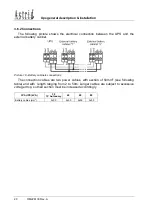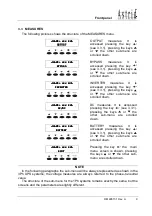
Ups general description & installation
14
OM226130 Rev. A
3.4 ELECTRICAL
CONNECTION
The electrical connection is part of the work which is normally provided by the
supplier that carries out the electrical installation and not by the UPS manufacturer. For
this reason, the following recommendations are only an indication, as the UPS
manufacturer is not responsible for the electrical installation.
In any case we recommend to carry-out the installation and the electrical connections
of the input and output in compliance with the local standards.
During the electrical installation take particular care to check the phase rotation with
a suitable instrument.
- UPS from 20KVA to 30 KVA
The terminals are positioned at the front of the UPS and they can be accessed by
opening the front door.
- UPS from 40KVA to 80 KVA
The terminal boards are positioned at the front of the UPS, under the breakers. To
access the terminals remove the protection, extracting the fixing bolts.
WARNING
The connection to the mains must be carried out with protection fuses or circuit
breakers between the mains and the UPS.
The use of residual current devices in the line supplying the UPS is
unadvisable. The leakage current due to the RFI filters is rather high and it can
cause spurious tripping of the protection device.
According to the EN50091-1 standard, in order to take into account the UPS’ leakage
current, residual current devices having adjustable threshold can be used (see tables).
1Ph UPS (kVA)
20
30
Leakage current L1-L2-L3-N (mA)
30
30
Leakage current L1-L2-L3 (mA)
200
200
3Ph UPS (kVA)
20
30
40
60
80
Leakage current L1-L2-L3-N (mA)
30
30
40
40
80
Leakage current L1-L2-L3 (mA)
20
20
20
20
30
The connection cables section is shown in the following tables.
1Ph UPS (kVA)
20
30
Rectifier 3x50
3x80
Input fuses (A)
Bypass 1x150
1x200
Rectifier 3x10
3x25
Input cables (mm
2
)
Bypass 2x35
2x70
Output cables (mm
2
)
2x35 2x70
Battery cables (mm
2
)
2x16 2x25
















































